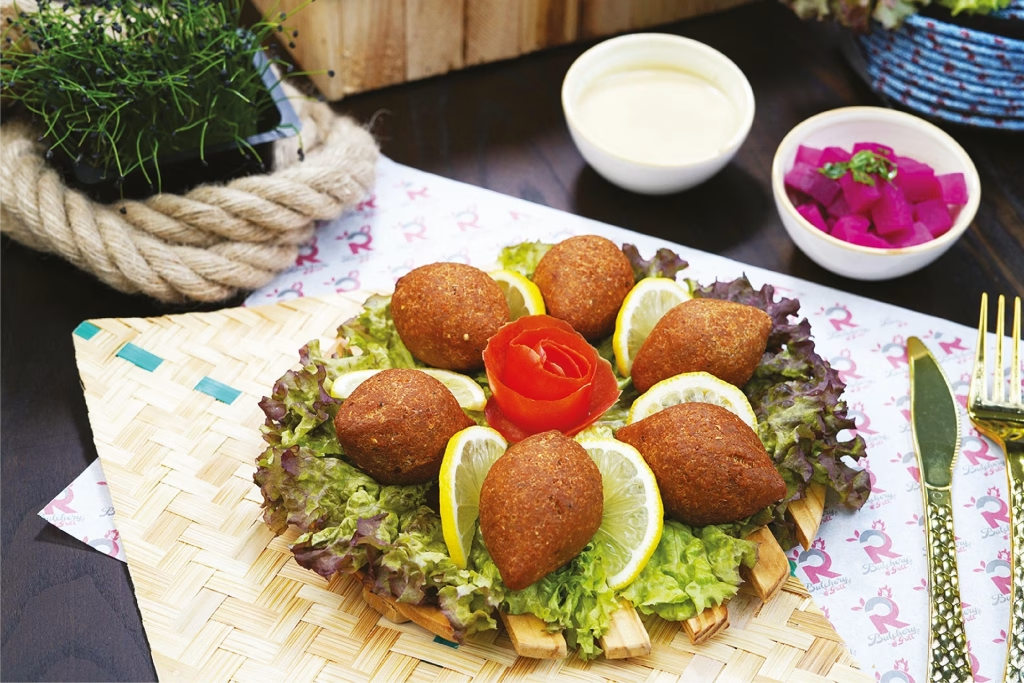Kibbeh (Lebanon) is more than just a dish, it’s a cultural emblem of Levantine cuisine, deeply rooted in Lebanese culinary traditions.
Made primarily from bulgur wheat, finely minced meat (typically lamb or beef), and fragrant spices, kibbeh is a versatile dish that can be baked, fried, served raw, or cooked in broth. Its unique flavor and texture have made it a staple in Lebanese households and festive meals alike.
In this comprehensive guide, we’ll walk you through an authentic recipe for Kibbeh (Lebanon), provide helpful tips, share creative variations, offer healthier alternatives, and dive into its rich history. Whether you’re making it for a dinner party or trying it for the first time, this article is your complete resource for mastering this Lebanese delicacy.
Table of Contents
Ingredients for Kibbeh (Lebanon)
For the Kibbeh Shell:
- 2 cups fine bulgur wheat
- 500 grams (1.1 lbs) lean ground lamb or beef
- 1 medium onion, finely grated
- 1 teaspoon ground allspice
- ½ teaspoon ground cinnamon
- ½ teaspoon black pepper
- 1 teaspoon salt
- Cold water (as needed)
For the Filling:
- 250 grams (0.55 lbs) ground lamb or beef
- 1 large onion, finely chopped
- ½ teaspoon ground cinnamon
- ½ teaspoon ground allspice
- ¼ teaspoon black pepper
- ½ teaspoon salt
- ¼ cup pine nuts (toasted)
- 1 tablespoon olive oil or ghee
For Frying (if deep frying):
- Vegetable oil (enough for deep frying)
Serves
This recipe serves 6 to 8 people as a main dish or around 12 to 14 pieces of fried kibbeh if shaped as individual balls or torpedoes.
Step-by-Step Instructions
Step 1: Prepare the Bulgur
- Rinse the bulgur wheat under cold water until the water runs clear.
- Soak the bulgur in warm water for about 15–20 minutes until soft, then drain well and squeeze out excess moisture using your hands or a cheesecloth.
Step 2: Make the Kibbeh Shell Dough
- In a large mixing bowl, combine the drained bulgur, grated onion, ground lamb or beef, and all the shell spices (allspice, cinnamon, pepper, salt).
- Knead thoroughly with your hands for 10–15 minutes until the mixture becomes cohesive and dough-like. Add small splashes of cold water if needed to help bind it.
Step 3: Prepare the Filling
- Heat olive oil or ghee in a pan over medium heat.
- Sauté the chopped onion until translucent, then add the ground meat and cook until browned.
- Add the spices (cinnamon, allspice, pepper, salt) and mix well.
- Stir in toasted pine nuts. Let the filling cool before using.
Step 4: Shape the Kibbeh
- Wet your hands with cold water. Take a golf ball-sized amount of the kibbeh shell dough.
- Form into a ball, then use your index finger to make a hole in the center, gently shaping it into a hollow oval.
- Fill the cavity with 1–2 teaspoons of the meat filling.
- Seal the opening and form it into an oval or torpedo shape. Smooth the surface with wet hands.
Step 5: Cook the Kibbeh
Option 1 – Deep Fry (Classic):
- Heat vegetable oil to 350°F (175°C).
- Fry kibbeh in batches until golden brown and crisp (about 5–6 minutes).
- Drain on paper towels.
Option 2 – Bake:
- Preheat oven to 375°F (190°C).
- Place shaped kibbeh on a lightly oiled baking sheet and brush with olive oil.
- Bake for 25–30 minutes, flipping once halfway through for even browning.
Option 3 – Kibbeh Pie (Saniyeh):
- Spread half of the kibbeh dough in a greased baking dish, press evenly.
- Add the filling, then layer the remaining dough on top.
- Score into diamond shapes and drizzle with olive oil.
- Bake at 375°F (190°C) for 35–40 minutes until golden.

Serving Suggestions for Kibbeh (Lebanon)
- Serve hot with cool yogurt or cucumber tzatziki.
- Pair with a fresh fattoush or tabbouleh salad for a light and refreshing contrast.
- A wedge of lemon or lime on the side enhances the flavor.
- Serve with a drizzle of tahini sauce or garlic sauce (toum) for extra richness.
- For mezze platters, offer smaller versions with hummus, olives, pickled turnips, and warm pita bread.
Tips for Perfect Kibbeh (Lebanon)
- Use fine bulgur: Coarse bulgur won’t blend well into the shell.
- Knead thoroughly: The longer you knead the shell dough, the smoother and easier it is to shape.
- Keep hands moist: Wet hands prevent sticking while shaping.
- Don’t overstuff: Too much filling can break the kibbeh during frying or baking.
- Cool the filling: Hot filling can make the shell crack or fall apart.
- Use lean meat for shell: Fatty meat makes the dough too greasy.
- Chill before cooking: Letting kibbeh rest in the fridge for 30 minutes helps them hold shape better when frying or baking.
Healthier Alternatives
If you’re looking to enjoy Kibbeh (Lebanon) with a health-conscious twist, try the following:
- Bake instead of fry: Reduce calories and oil by baking the kibbeh.
- Use lean meats: Ground turkey or chicken works as a leaner substitute.
- Go vegetarian: Use lentils or mushrooms with onions and walnuts for the filling.
- Whole grain bulgur: Choose whole wheat bulgur for added fiber and nutrients.
- Air-frying: For a crispy finish without deep frying, try air-frying at 375°F for 12–15 minutes.
Creative Variations of Kibbeh (Lebanon)
- Kibbeh Nayyeh – A raw version of kibbeh made with fresh minced lamb and served cold with olive oil and mint. (Traditional and eaten fresh only in trusted settings).
- Pumpkin Kibbeh – Replace the shell meat with mashed pumpkin and fill with spinach, onion, and walnut mix. Great for vegetarians.
- Cheese-Stuffed Kibbeh – Insert a piece of mozzarella or akkawi cheese in the center for a melty surprise.
- Fish Kibbeh – In coastal regions, fish like trout or cod replaces red meat.
- Kibbeh in Yogurt Sauce (Labaniyyeh) – The kibbeh balls are boiled and served in a tangy yogurt sauce with garlic and mint.
- Grilled Kibbeh Skewers – Flatten kibbeh around skewers and grill like kebabs.
Common Mistakes to Avoid
- Using coarse bulgur: Makes shaping difficult and ruins the texture.
- Undrained bulgur: Excess moisture weakens the shell.
- Hot filling: Can melt or deform the shell during shaping.
- Over-frying: Dries out the interior while burning the shell.
- Skipping seasoning: Both shell and filling need their own seasoning.
- Overstuffing or under-sealing: Causes filling to leak during cooking.
- Skipping the chill time: Cold kibbeh holds shape better during cooking.
History of Kibbeh (Lebanon)
Kibbeh’s origin stretches deep into the ancient Levant, encompassing modern-day Lebanon, Syria, Jordan, and Palestine. Traditionally prepared by pounding meat and bulgur with a mortar and pestle, it was a dish of both labor and love, often prepared by women for family feasts, weddings, and religious celebrations. In Lebanon, kibbeh became a proud expression of home cooking, with each village and family crafting its unique twist.
In rural Lebanon, kibbeh is more than sustenance, it’s ritual. Making kibbeh was often a collective event, bringing together generations. Grandmothers passed the art of shaping the perfect torpedo to daughters and granddaughters. Its role in Christian and Muslim holiday feasts elevated it to a dish of spiritual and social significance, often prepared in large quantities and stored for future meals.
As Lebanese communities emigrated around the world, they carried the flavors of home with them. Kibbeh (Lebanon) has now become a symbol of identity and nostalgia for many Lebanese expats. Whether served in Brooklyn or Beirut, the dish continues to evolve while holding true to its origins—a celebration of flavor, tradition, and community.
FAQs About Kibbeh (Lebanon)
- Can I freeze kibbeh?
Yes! Shape and freeze uncooked kibbeh in a single layer on a tray, then transfer to a freezer bag. Fry or bake from frozen. - What meat is traditionally used in kibbeh?
Lamb is traditional, but beef is also widely used. Use lean cuts for the shell and slightly fattier meat for the filling. - Is kibbeh gluten-free?
Traditional kibbeh is not, due to bulgur wheat. You can use gluten-free quinoa or rice as a substitute, though texture may vary. - How do I make vegetarian kibbeh?
Use a shell of pumpkin or sweet potato with bulgur and a filling of spiced lentils, onions, and walnuts. - Can I prepare kibbeh in advance?
Yes. You can refrigerate shaped kibbeh for up to 24 hours or freeze for up to 2 months. - What’s the difference between baked and fried kibbeh?
Fried kibbeh is crispier and richer; baked kibbeh is lighter and healthier, with a similar flavor. - What sauces go well with kibbeh?
Tzatziki, tahini sauce, garlic sauce (toum), or a simple yogurt dip with mint. - Can I use food processors instead of kneading?
Yes, especially for the shell. Use short pulses to avoid overprocessing the meat. - What should the texture of kibbeh shell be like?
Smooth, cohesive, and firm enough to shape without crumbling or breaking. - Is kibbeh suitable for kids?
Absolutely, especially the baked or pan-fried versions. Just adjust spice levels to their preference.
Kibbeh (Lebanon) is more than just a recipe, it’s a deeply cultural experience that connects generations through food. With its signature blend of seasoned meat, aromatic spices, and hearty bulgur, kibbeh offers a satisfying bite of Lebanon’s rich culinary heritage. Whether you choose to fry, bake, stuff, or layer it, there’s a version for every palate and lifestyle.
From festive occasions to everyday meals, kibbeh brings people together around the table. With the tips, variations, and historical context provided in this article, you’re now equipped to craft your own authentic version of this timeless Lebanese treasure.
Ready to cook your first batch of Kibbeh (Lebanon)?


